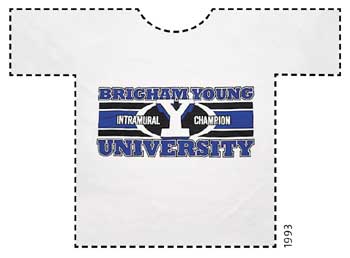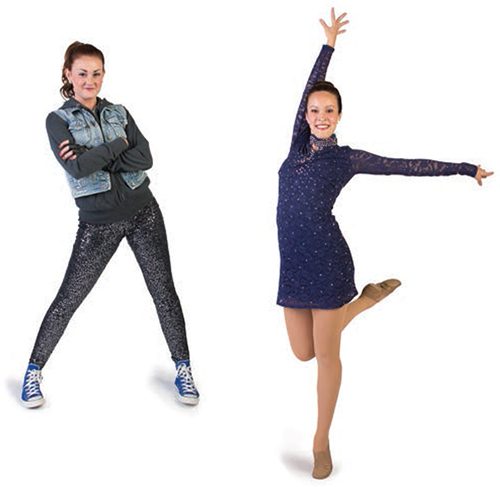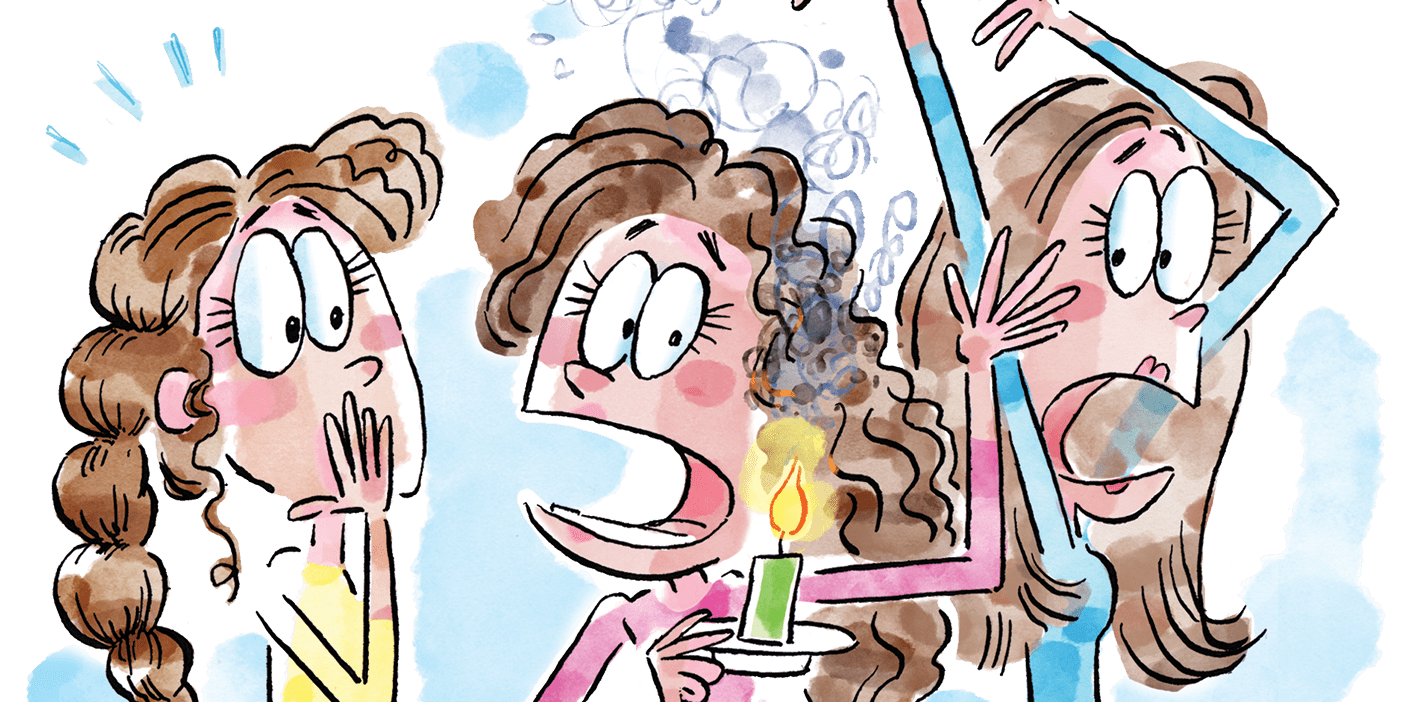THE intramurals stories sent by alums recall a host of hilarious moments, vivid memories, and injuries earned in the heat of competition. Some of them warmed our hearts; others made us laugh out loud. May they do the same for you.
1940s-Style Intramurals
Glen E. Allred, ’49, Bountiful, Utah
Intramurals at BYU before World War II were a far cry from what they are today. During this period Fred “Buck” Dixon of the faculty was in charge of the program and Keith Wilson was the student manager.
My greatest experience in the program was in the spring of 1942 when the annual horseshoe pitching tournament was held. The competition in the early rounds was not too tough, but when I reached the championship match, I met a very tough opponent, the quarterback on the football team—Herman Longhurst from Pocatello, Idaho. I don’t know about Herman, but I was pitching the best I had ever pitched, and both of us often had double ringers, which would cancel us out. After quite a struggle I finally emerged as the intramural champion in horseshoes. Before the end of that year, many of us would be in the armed forces training for war.
A Reminder of Conversion
Jennifer Bassarear, ’79, Bountiful, Utah
I had joined the Church only two years before coming to BYU for my sophomore year. I happened to land in a branch we affectionately called “The Great 91st,” in the 5th stake. Our branch was full of extremely talented sisters, and our branch president, Mac Boyter, was often teased by other branch presidents about the possibility that he was recruiting athletes to live in the Brownstone and Brockbank Apartments. During ’76-77, we won the 12-stake and all-university tournaments in softball. And in basketball we lost the championship game of the 12-stake tournament but won the all-university tournament.
Winning was always great—that goes without saying. But what made it wonderful was the support we got from the brothers in our branch. Our home teachers gave us roses before every championship game. Our branch brothers actually brought pom-poms and cheered for us—at nearly every game! And President Boyter more often than not would take us all out for ice cream after a big game.
Those are some of the greatest memories I have from college, maybe even better than playing competitively for BYU. Our intramural fun cemented some lifelong friendships. It also helped me remember what it was that brought me into the Church in the first place—the camaraderie between sisters, friendships between brothers and sisters, the joy of living the gospel and serving one another, and having a great time doing it.
Winning the Ward Award
Craig A. Lofgreen, ’82, Seattle
In 1978 I was a freshman living in Helaman Halls. One Saturday morning I donned a very fashionable blue silk disco shirt, baby blue bell-bottom cords, and high gum-soled shoes, hopped on my trusty Raleigh Grand Prix 10-speed bicycle, and headed up the hill to campus. As I approached the top of the hill, I noticed a number of students in tights, special shoes, and brightly colored racing shirts carrying their bikes toward the north side of the Marriott Center. Curious, I followed. It turned out to be an intramural bicycle race.
As I stood there the official handing out numbers asked me if I was participating. I looked at my clothes, back at him, and asked, “You’re kidding, right?” He wasn’t. I took a number. After I positioned myself in the pack and tucked my bell-bottoms into my socks, I turned to a fellow racer and asked, “What do I do?” I was to ride 11 times around a course marked with orange cones.
At the sound of the gun we were off. Fifteen or so highly trained racers and one disco guy. I had run track in high school and had signed up for the mandatory Fitness for Life class, but nothing had prepared me for this. I pedaled for all I was worth. After the first lap I was in last place. After the second lap I was still in last place.
In the third lap, a biker in the middle of the pack fell. He took out several other bikers with him. As I came on the scene, I slowed and offered assistance. They all waved me on—they didn’t know I was looking for an honorable way to get out of the race. So, to keep dignity and despite my burning lungs and screaming legs, I kept pedaling. With each lap I got further behind. Finally I crossed the finish line and collapsed on a nearby patch of grass.
As I lay there, the official came over and asked me if I had entered as an individual or as a ward. “Huh? I don’t know. Ward, I guess.” Minutes later he came back and congratulated me for taking first in my category. All the other racers had entered as individuals. After seeing my dark blue “Intramural Champion” T-shirt, the guys from my dorm came by my room to congratulate me. I never told them the whole story. Until now.
Training for Life
Steven R. Corry, ’83, Mission, Kan.
My intramurals participation—as an athlete and a supervisor—provided training for a recreation career that now spans 20 years.
I learned that the customer can have more sense than the employee when I became soaking wet in a heavy thunderstorm the first night I ran the soccer program. No one showed up, but I was drenched by the motto “We never cancel intramurals for weather.”
I also learned that the one was just as important as the many. We had leagues that served 600 teams; we had activities where only two came to play. We had aerobic nights where the first 500 could participate; we offered chess where someone in a wheelchair stood on even ground.
BYU is supposed to be a training ground for life, not just an education. For many students and staff members, intramurals were exactly that.
Flag Victim
Brian S. Wootan, ’86, Red Hook, N.Y.
As a member of the BYU rugby team, I didn’t have the time or inclination to play intramural sports, especially not flag football. Football itself is the weak step-sister of rugby, and flag football was beneath notice.
One of my best friends on the team was a psychotic named Kent. He loved flag and had his own team, often running off after our three-hour practices to play. One night he was short a man and twisted my arm until I agreed to stand in.
On the opening kickoff, Kent took the ball and moved downfield. Passing and looping, we easily scored. In fact, we scored pretty much every time we touched the ball. I was starting to enjoy flag for the first time.
Unfortunately, we couldn’t play defense, so the score stayed even. Kent was getting frustrated and decided to help my pass rush with a blitz. He came crashing through in his usual manic style and jumped about 10 feet in the air in front of the quarterback (I expect he was going to squash the poor fellow, a particular move of his on the rugby pitch). The quarterback dodged, and Kent landed on my shoulder, completely dislocating it.
Off I went to the Health Center. There I was surrounded by the night’s flag victims, a sorry collection of broken bones, sprained ankles, and deep cuts. Even by rugby standards, it was an impressive group of injuries. I was relocated, fitted with a sling, and sent home, where I had the distinct privilege of explaining to my wife that she would be tying my shoelaces for the next six weeks.
As painful as the injury was, the collateral damage was worse. I missed the rest of the fall rugby season and was forced to endure endless commentary from my teammates about what sort of person gets hurt playing flag football. Fortunately, I was able, by way of grunts and vague, mumbled replies, to convince the rest of the world that my wound was honorably earned on the rugby pitch.









